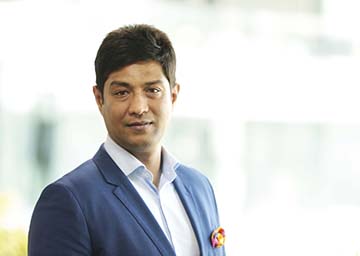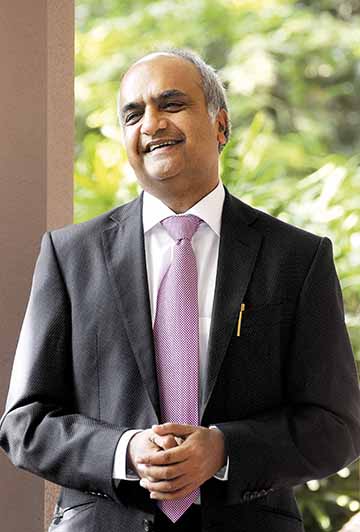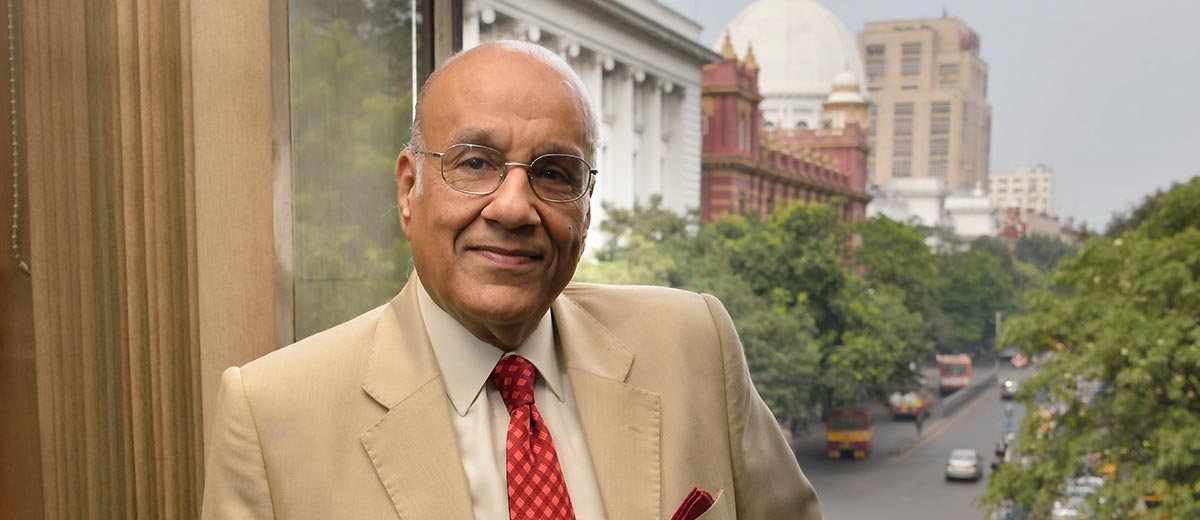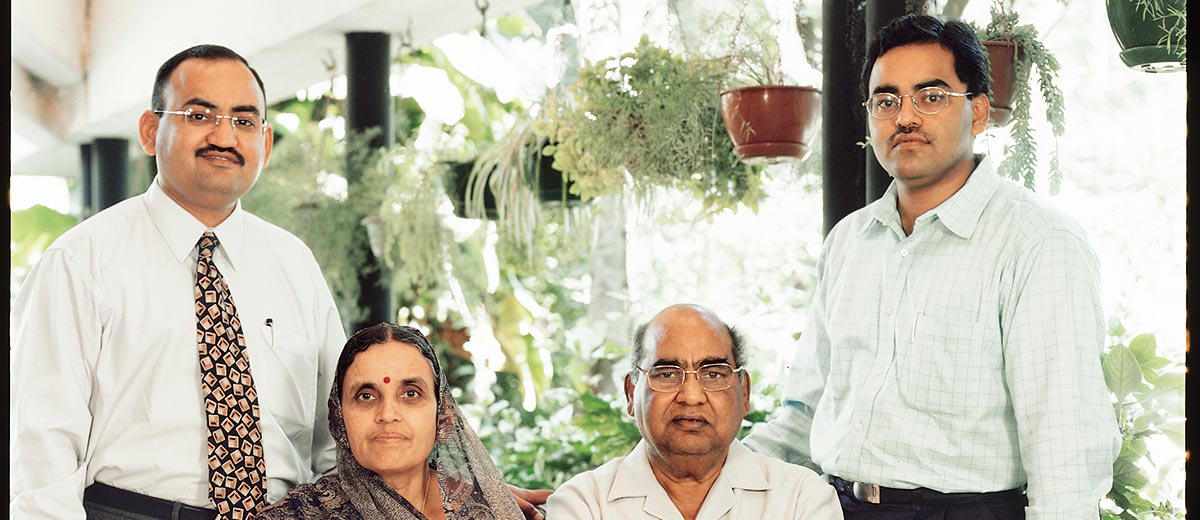
The Fiction Thriller Maestro
The Fiction Thriller Maestro
Few writers in the Indian fiction thriller genre measure up to Ashwin Sanghi, who is counted among India’s highest-selling English fiction authors. The prolific writer, who already has a series of bestselling titles to his name, is now back with a whopper of a plot in his new book, Keepers of the Kalachakra, that was released earlier this year. The author talks to MARWAR about the book, his other works and his future plans.
Text: Joseph Rozario
 ailing from a Mumbai-based Marwari business family, like most other Marwari youngsters, Ashwin Sanghi’s efforts too were directed at being a part of the family business and furthering it like a motivated scion. Arming himself with a master’s degree in business management from the Yale School of Management, USA, to this end, the first 12 years of his career were spent trying to fit into the family business machinery and grooming himself simultaneously to master the art of wealth creation. But fate had him master the art of storytelling instead. A holiday to Kashmir, while still firmly embedded in the family business, proved to be the turning point.
ailing from a Mumbai-based Marwari business family, like most other Marwari youngsters, Ashwin Sanghi’s efforts too were directed at being a part of the family business and furthering it like a motivated scion. Arming himself with a master’s degree in business management from the Yale School of Management, USA, to this end, the first 12 years of his career were spent trying to fit into the family business machinery and grooming himself simultaneously to master the art of wealth creation. But fate had him master the art of storytelling instead. A holiday to Kashmir, while still firmly embedded in the family business, proved to be the turning point.
In Kashmir, there is this fascinating story that Jesus is buried in the Rozabal shrine of Srinagar. Intrigued by the story, Sanghi plunged himself into intense research on the subject so much so that a nudge from his wife was all that was required to motivate him to put down all the material he had gathered on the subject in the form of a book. Over the next year, weaving in elements to make it a suspense thriller, he had written enough for his first book, The Rozabal Line. Initially self-published (in 2007), under the pseudonym, Shawn Haigins, the fiction thriller subsequently evinced interest from Westland Books, who published it in 2008 in India under his own name. The book went on to become a national bestseller.
 With Chanakya’s Chant, The Krishna Key, The Sialkot Saga—all bestsellers—and a New York Times bestselling crime thriller, Private India—written with American author James Patterson— following in quick succession, Sanghi today ranks among India’s highest selling English fiction authors.
With Chanakya’s Chant, The Krishna Key, The Sialkot Saga—all bestsellers—and a New York Times bestselling crime thriller, Private India—written with American author James Patterson— following in quick succession, Sanghi today ranks among India’s highest selling English fiction authors.
While Chanakya’s Chant (launched in 2011) went on to win the Crossword Popular Choice Award and remain on AC Nielsen’s India Top-10 list for over two years, The Krishna Key (released in 2012) shot to #1 on the AC Nielsen all-India fiction rankings within the first week of its release. The Sialkot Saga (released in 2016) too soared to #1 on the AC Nielsen bestseller list within the first week, and Private India (released in 2014) hit #1 on AC Nielsen’s India Fiction list and then hit the UK Top-10 six weeks later.
The fiction thriller maestro is now back with another gripping, fast-paced tale that seamlessly weaves history, science, theology, mythology, politics and philosophy into an exhaustively researched whopper of a plot. Titled ‘Keepers of the Kalachakra’, the book is about men who guard the ‘Kalachakra’ or ‘The Wheel of Time’. It describes a world of people at war with the other, in a boomeranging conflict of faiths that results in acts of slow, planned human cruelty that defy human imagination.
We bring you a tête-à-tête with the prolific author, followed by excerpts from the book.
Q&A
- What would you call Keepers of the Kalachakra—a fiction, part-fiction or sci-fi?
Keepers of the Kalachakra is fiction, and we must not forget that. In my Bharat series books, I always use mythology, theology, science, current affairs and history as backdrops to make my fiction sound more believable, but ultimately the book is fiction.
- Your book seems to echo some of unfortunate goings-on in the world today. Your comments.
Fiction is always influenced by what is happening in the world. All of the issues that I have touched upon—the rise of extremism, polarisation, terrorism, fundamentalism—are real issues that the world must indeed grapple with.
- How easy or difficult was it to write Keepers of the Kalachakra? Did you feel the book, or at least some sections of it, could be wrongly interpreted?
 This was, by far, the most difficult book I have ever written. I do not have a science or engineering background and this meant that I needed lots of help to understand the issues involved in the world of quantum physics. To combine elements of quantum theory with Eastern philosophy was thus my greatest challenge.
This was, by far, the most difficult book I have ever written. I do not have a science or engineering background and this meant that I needed lots of help to understand the issues involved in the world of quantum physics. To combine elements of quantum theory with Eastern philosophy was thus my greatest challenge.
As regards misinterpretation, I believe that virtually anything can be misinterpreted. Why did Mary’s little lamb have fleece that was “white as snow”? That could be viewed as a racist comment. My readers are aware of the fact that I try building bridges between religions and focus on the unity of multiple spiritual traditions. How can that be misinterpreted?
- Do you feel your book will have readers introspect, and in that, work towards a positive world view?
I would hope so. But then, I am a mere paperback thriller writer. I do not try to attribute lofty ideals or objectives to my novels. My primary aim is to entertain. Along the way, I hope that I will also educate by giving you nuggets of information that you did not know. And finally, by the last few pages, I hope to provide you with an “Aha!” moment. That’s a moment of enlightenment when you realise the bigger picture.
- Though English is spoken the world over, your books typically have Indian themes. Why is this?
Because my readership is primarily Indian. There is an entire generation of Indian readers who are attempting to explore their history, mythology, culture and religion through contemporary stories that strike a chord with them. I write for them.
- This is the fifth book from your Bharat series. What are the other series under which you write?
 I have written two books in the Private series alongside James Patterson. These are crime thrillers that are set in Mumbai and Delhi and both have been New York Times bestsellers. In addition, I also co-author and mentor a series of self-help and motivational books called 13 Steps. Till date, we have published three books in this series, viz, 13 Steps to Bloody Good Luck, 13 Steps to Bloody Good Wealth and 13 Steps to Bloody Good Marks. Three more titles are currently in various stages of writing and editing.
I have written two books in the Private series alongside James Patterson. These are crime thrillers that are set in Mumbai and Delhi and both have been New York Times bestsellers. In addition, I also co-author and mentor a series of self-help and motivational books called 13 Steps. Till date, we have published three books in this series, viz, 13 Steps to Bloody Good Luck, 13 Steps to Bloody Good Wealth and 13 Steps to Bloody Good Marks. Three more titles are currently in various stages of writing and editing.
- One hears very little about your family business. Tell us a little about it.
 My grandfather established the business in the 1930s in erstwhile Rajputana—Jodhpur, Jaipur, Udaipur, Ajmer, Bikaner, etc. This was a business dedicated to selling luxury cars to the princely states. My father and his brothers moved to Mumbai and Delhi in 1961 to widen the footprint. Today our business encompasses automobile distribution, real estate development, manufacture of industrial gases and engineering. My father and elder brother are actively involved in the business, hence I am afforded the luxury of being a writer.
My grandfather established the business in the 1930s in erstwhile Rajputana—Jodhpur, Jaipur, Udaipur, Ajmer, Bikaner, etc. This was a business dedicated to selling luxury cars to the princely states. My father and his brothers moved to Mumbai and Delhi in 1961 to widen the footprint. Today our business encompasses automobile distribution, real estate development, manufacture of industrial gases and engineering. My father and elder brother are actively involved in the business, hence I am afforded the luxury of being a writer.
- What next?
I hope to complete three titles in the 13 Steps series quickly before commencing my next book in the Bharat series. At the present moment, I am tossing around three competing ideas and hope to narrow that down to a single one in a couple of months
EXCERPTS FROM KEEPERS OF THE KALACHAKRA
Prologue – Part 1
 The young man lay on the floor, reaching helplessly for his left arm with his right. His howls were like those of an injured animal. Surrounding him were officers of the WHMU, the White House Medical Unit, as also agents from the Secret Service. Standing still, some distance away, was the President himself. The goggle-eyed guests who had been invited to the state dinner at the White House were ushered out with a minimum of fuss from the State Dining Room and into the adjoining Red Room. The support staff was at its efficient best, although no one knew what the hell was going on. The most they could conclude was that Jean Belanger, the Prime Minister of Canada, was in a bad way.
The young man lay on the floor, reaching helplessly for his left arm with his right. His howls were like those of an injured animal. Surrounding him were officers of the WHMU, the White House Medical Unit, as also agents from the Secret Service. Standing still, some distance away, was the President himself. The goggle-eyed guests who had been invited to the state dinner at the White House were ushered out with a minimum of fuss from the State Dining Room and into the adjoining Red Room. The support staff was at its efficient best, although no one knew what the hell was going on. The most they could conclude was that Jean Belanger, the Prime Minister of Canada, was in a bad way.
A medic held a cotton swab to Belanger’s mouth as he coughed. There was blood in his sputum. Even in his semi-comatose state, Belanger felt a maddening urge to scratch his left arm, to rip his own skin off. One of the nurses from the medical team quickly snipped off his jacket and shirt to expose the arm that seemed to be causing all the trouble. And that’s when they saw it.
It was a dark red and was twice the size of his other arm. All over his skin were scarlet blisters, pustules that oozed a strange mixture of blood and watery plasma.
‘I think he’s been poisoned,’ said the WHMU Director, a man also designated as Physician to the President. ‘There’s no time to lose. His heart rate is rapidly dropping!’ Upon a nod, the Director’s assistant hurried over with a defibrillator. ‘Charge it to two hundred joules,’ ordered the Director.
‘Yes, sir,’ answered the assistant, kneeling on the floor next to Belanger. He applied two gel pads, one on Belanger’s upper chest, below the right clavicle,
Continued on page 46
XXXXXXXXXXXXXXXXXXXXXXXXXXXXXXXXXXXXXXXXXXXXXXXXXXXXXXXXXX
REVISITING HISTORY
 The M K Sanghi Group traces its origin to
The M K Sanghi Group traces its origin to
Motilal Sanghi, whose entry into the world of enterprise began with a general merchandise store in his native Jodhpur. Motivated and driven, he prospered, which led to his foray into other businesses like car distributorship, cinemas and manufacture of industrial gases and plants. His businesses were further expanded and strengthened by Narendra Sanghi his eldest son initially, who was also Congress MP for 14 years and then by his youngest son, Mahendra Sanghi, who was sent to Mumbai in 1962 to extend the Sanghis’ footprint to the financial capital of India.
To celebrate his life and immortalise his contributions to business, philanthropy and culture, his wife, Manju Sanghi has written a biographical account of his life. Titled MK Sanghi—Life, Love & Laughter, the book talks about the man, his persona, his business initiatives, his style of management, his successes, his missteps and other facets of his life, including his love for tradition and culture, squash, food and his Jodhpur origin. It also offers a glimpse of M K Sanghi as a beloved husband and doting father to three children—Vidhi, Vaibhav and Ashwin—who have shared their memories and written about their father in the book.
We bring you an excerpt from MK Sanghi—Life, Love & Laughter.
EXCERPTS FROM MK SANGHI—LIFE, LOVE & LAUGHTER
MK has always done things with aplomb. His early interest in business chambers eventually grew into a full-fledged passion. He loved being involved in charting the path of Indian business and trade. The Indian Merchants’ Chamber, a premier body set up in 1907, held great fascination for MK. In 1990, when Pravinchandra Gandhi, a close friend asked MK to become IMC president, MK proudly shouldered the responsibility. IMC is the only Chamber in which Mahatma Gandhi was an honorary member. It was a well-run organisation, and its activities kept him happy and occupied. Among the many luminaries that MK invited to address the IMC during his tenure, were APJ Abdul Kalam, who was then a part of the Department of Atomic Energy, and Russi Mody, the Chairman and MD of Tata Steel, besides fourteen Central Cabinet ministers, by itself a unique achievement. A decade later, MK would become president of the India Chapter of the International Chamber of Commerce and transform it into one of ICC’s most active chapters. He thus played a crucial role in influencing economic policies as Indian businesses made strides towards globalisation.
 However, it was at ASSOCHAM that MK surpassed himself, astounding us all with his acumen and sheer genius. ASSOCHAM was a notable organisation, which had earlier been led by people such as Viren Shah, Keshub Mahindra, A N Haksar and L M Thapar. But by 2003, it was almost on its last legs. Although its members, both companies and professionals from across the country, ran into several thousands, it had reached a point when it was unable to even pay staff salaries. Its secretary-general had also resigned while FICCI and CII, the two rival national chambers, were going great guns – their secretaries Tarun Das and Amit Mitra calling the shots with the government. All told, there were too many challenges and it was a critical time.
However, it was at ASSOCHAM that MK surpassed himself, astounding us all with his acumen and sheer genius. ASSOCHAM was a notable organisation, which had earlier been led by people such as Viren Shah, Keshub Mahindra, A N Haksar and L M Thapar. But by 2003, it was almost on its last legs. Although its members, both companies and professionals from across the country, ran into several thousands, it had reached a point when it was unable to even pay staff salaries. Its secretary-general had also resigned while FICCI and CII, the two rival national chambers, were going great guns – their secretaries Tarun Das and Amit Mitra calling the shots with the government. All told, there were too many challenges and it was a critical time.
But challenges seem to attract MK like a moth to a flame. We just prayed that he wouldn’t get burned. Although he was initially hesitant to take up on his friend Ram Gandhi’s request to head an organisation that appeared to be in the doldrums, MK grew quite keen as the days passed. In the meantime, industry bigwigs such as Harishankar Singhania, K P Singh, L M Thapar, Avijit Mazumdar and Pravinchandra Gandhi encouraged him, expressing unequivocal confidence in MK’s ability to restore the fading organisation to its former glory. MK soon overcame his initial hesitation and picked the gauntlet.
About the author
Manju Sanghi currently looks after the M K Sanghi Group’s charitable activities. She has earlier served as President of Indian Merchants’ Chamber Ladies Wing.
XXXXXXXXXXXXXXXXXXXXXXXXXXXXXXXXXXXXXXXXXXXXXXXXXXXXXXXXXX
and the second below his left nipple. Pressing the paddles firmly onto the gel pads, he applied twenty-five pounds of pressure. ‘All clear!’ he shouted as he depressed the shock button on the paddles. Belanger’s body jolted as the current hit. The Director stared at the monitor, hoping for a stable rhythm.
 And then, Belanger retched. The vomit splattered over his tuxedo, trickled down and was slowly absorbed by the thick pile of the pale blue wool carpet on the State Dining Room floor. ‘We must shift him to Bethesda immediately,’ said the Director. He stole a glance at the President to seek his concurrence. The President nodded wordlessly.
And then, Belanger retched. The vomit splattered over his tuxedo, trickled down and was slowly absorbed by the thick pile of the pale blue wool carpet on the State Dining Room floor. ‘We must shift him to Bethesda immediately,’ said the Director. He stole a glance at the President to seek his concurrence. The President nodded wordlessly.
Within seconds, an Air Force chopper landed on the helipad in the South Lawn and Belanger was efficiently shifted into it. As he was being slid in, the Director saw the next telltale sign.
Belanger’s face, like his arm, was now severely swollen, but on the right side. It had ballooned to the extent that his right eye was no longer visible. The Director quickly got into the helicopter along with other medics. In the distance, he could see men dressed in bio-hazard suits running across the lawn towards the White House. They were carrying canisters of chlorine dioxide to fumigate some areas. They had to keep in mind the possibility that anthrax had been used. Belanger’s symptoms of nausea, blisters, swelling and shortness of breath were similar to the effects of anthrax poisoning, but no one could be sure.
As the chopper took off, the Director glanced through the window at the President who was standing in his white-tie get-up on the South Lawn, his jet-black hair blown awry by the whirling rotors.
He was intently observing the helicopter as it lifted off the ground.
——————————————————————
Prologue – Part 4
 The Walter Reed National Military Medical Center, located in Bethesda, Maryland, was abuzz, given the profile of it latest patient. The hospital was renowned for the number of famous people who had been treated there. The staff had long grown used to the arrival of powerful people. John F. Kennedy had been rushed there after his assassination. Ronald Reagan had undergone surgery for his prostate cancer at Walter Reed. George Bush had been taken there for treatment of his atrial fibrillation. But the arrival of any President or foreign head of state in critical condition was always a cause for madness to prevail.
The Walter Reed National Military Medical Center, located in Bethesda, Maryland, was abuzz, given the profile of it latest patient. The hospital was renowned for the number of famous people who had been treated there. The staff had long grown used to the arrival of powerful people. John F. Kennedy had been rushed there after his assassination. Ronald Reagan had undergone surgery for his prostate cancer at Walter Reed. George Bush had been taken there for treatment of his atrial fibrillation. But the arrival of any President or foreign head of state in critical condition was always a cause for madness to prevail.
The WHMU Director quickly briefed the doctors as Belanger was wheeled into the Intensive Care Unit. ‘His pulse is erratic, his left arm and the right side of his face are swollen. He has developed bright red pustules on his arm and his heart rate has been in decline. He’s thrown up several times. We’ve taken blood samples during the chopper ride. How quickly can you get me a toxicity report?’
‘It’s done,’ said the senior pathologist on the scene. The newest machines at Bethesda spat out such reports almost instantly. ‘It’s crazy but he has all the symptoms of snakebite. But there aren’t any snakes in the White House and there is absolutely no poison in his system.’
No snakes in the White House? wondered the WHMU Director. I’m not sure the President would agree. He seems to think that everyone around him bears shades of the reptilian.
 ‘I have bad news and worse news,’ said the young US Navy Commander who was also the on-duty doctor at the ICU. ‘Which will it be?’ he asked as he scanned the reports.
‘I have bad news and worse news,’ said the young US Navy Commander who was also the on-duty doctor at the ICU. ‘Which will it be?’ he asked as he scanned the reports.
The WHMU Director brusquely replied, ‘Both!’
‘The bad news is that his kidneys seem to be shutting down for no apparent reason. The worse news is that intravascular coagulation has begun impeding his blood circulation. If we do not figure out a course of treatment, he will soon go into coma.’
The words, ‘Death will inevitably follow’, were left unsaid.










